- 408-924-7560
- mineta-institute@sjsu.edu
- Donate
Newsletter Fall 2012: Vol. 19, Issue 2
The impact of MAP-21 on the UTC Program
Rod Diridon, Executive Director
 MAP-21 is the new 27-month surface transportation authorization bill enacted earlier in the summer. The program includes three categories of centers: five National Centers at $3 million per year with a 100% match; ten Regional Centers at $2.25 million each with a 100% match; and up to 20 Tier I Centers at $1.5 million each with a 50% match required. While consortia are encouraged for the National and Regional Centers, the Tier I Centers are not expected to be consortia.
MAP-21 is the new 27-month surface transportation authorization bill enacted earlier in the summer. The program includes three categories of centers: five National Centers at $3 million per year with a 100% match; ten Regional Centers at $2.25 million each with a 100% match; and up to 20 Tier I Centers at $1.5 million each with a 50% match required. While consortia are encouraged for the National and Regional Centers, the Tier I Centers are not expected to be consortia.
Current Consortium Comparison
For comparison, the UTC competition winners announced at the beginning of this year included 22 consortia, two of which are designated for transit emphasis (MNTRC included), providing funding to consortium members at 121 universities. The consortium contracts currently end on December 31, 2013, with the ability to expend unused funds until the end of 2014. Each may be extended a year. An unexpected second year (2013 calendar year) of funding was recently appropriated by congress. RITA has announced that those funds will be released for the consortium program use. The individual consortium funding levels have not yet been confirmed though that announcement from Secretary LaHood’s office is expected soon.
The Overlap
Overlapping the consortium contracts, the new Map 21 three-tier process is expected to begin with a competition in early 2013 with the winners to be announced and, apparently, the contracts effective by the September 30, 2013 FFY end. The original contract period will apparently extend until September 30, 2015 with unexpended fund expenditure authority until the end of the following FFY. Based on tradition (not a reliable assumption recently), Congress might be expected to extend the MAP-21 authorization and the contracts could well run for four or more years before the next competition. How the consortia and MAP 21 processes melds together is surely going to be a challenge for RITA, and each of us, hopefully.
The Course Ahead
The Mineta National Transit Research Consortium (MNTRC) is considering the course ahead and must decide in time to respond to the next request for proposals, apparently shortly after the beginning of the coming year. No matter the MAP-21 direction, MNTRC will continue to complete the current consortium contract requirements through the end of the 2014 calendar year. That contractually required and honorable approach will not only provide the nation with MNTRC’s best products but also create strong performance metrics to help each consortium university during the MAP-21 and future competitions.
Current Status
In the interim, MNTRC and MTI continue to thrive. With 18 MNTRC research projects in process, nearly 25 outreach programs complete or planned, the consortium web site functioning well, and the shared education task force developing, all required performance metrics will be exceeded. The MNTRC is prepared for the second round of consortium funding and ready for whatever MAP-21 has to offer. And, thankfully, Deputy Executive Director Karen Philbrick, who is as wonderful a Mom as she has been a Research Director, returns from maternity leave in a few weeks.
Board Profile: Grace Crunican
by Donna Maurillo, MNTRC Director of Communications
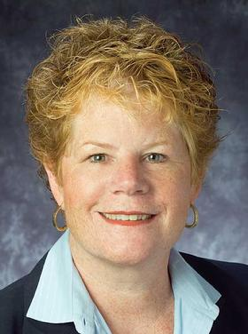
Grace Crunican
General Manager,
Bay Area Rapid Transit
Running a transit service for a major metropolitan area is no walk in the park. But Grace Crunican, general manager of the Bay Area Rapid Transit (BART) service, has faced the challenges head-on. The rail transit system serves the greater San Francisco Bay area, which includes Oakland and the East Bay. BART includes operating and capital budgets totaling $1.4 billion, plus about 3,100 employees who serve about 350,000 riders each weekday with service at 44 stations in four counties. Currently, her team at BART is constructing a new station that will add service between Fremont and the Berryessa district of San Jose, a 10-mile, $2.3 billion extension, which has been long anticipated. One of her plans is to create a sense of the neighborhood at each BART stop, perhaps with color or other elements. Station maintenance and infrastructure will remain a priority, but she believes that BART can help provide a sense of community and identity.
She knows how to show the money
One of her strengths is the ability to obtain federal funding. When she was a deputy in the Federal Transit Administration in Washington, she negotiated more than $3 billion in New Start Rail Projects. She also knows how to work her way around controversial issues, which often face any agency providing a public service.
Ms. Crunican arrived in California with solid credentials in finance. As deputy director and capitol project manager for the City of Portland OR, she increased its dedicated transportation funding from 23 to 55 percent.
She’s even worn greasepaint
She was director of Seattle’s Department of Transportation when she led the move to gain public approval for a $590 million investment in that city’s road, bridge, sidewalk, and transit facilities. She also helped with design, finance and construction of a city streetcar line that opened with 48 percent in private partnerships.
Her first paying job? She admits to having been a clown at the Portland Zoo.
MNTRC is fortunate to have Ms. Crunican serving on its Board of Trustees, especially given her experience at the federal level and with transit services.
How we can increase sustainable transit
Charles Standridge, PhD, Assistant Dean, Padnos College of Engineering and Computing
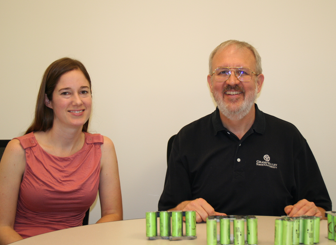
Professor Lindsay Corneal of the GVSU School of Engineering and Dr. Charles Standridge work with unassembled lithium-ion battery packs.
GVSU NEWS – Faculty, graduate students, and staff from Grand Valley State University’s School of Engineering and the Michigan Alternative and Renewable Energy Center(MAREC) have a valuable and challenging project. They are continuing their research on remanufacturing, repurposing, and recycling electric batteries from transit vehicles. The special focus is on lithium-ion batteries.
The team is working in partnership with Sybesma’s Electronics, a third-generation family owned business in Holland, Michigan, to insure that the work has industrial applications. The project’s overarching goal is to provide better economic value to transit operators who use electric vehicles, thus increasing the sustainability of public transit.
Lithium supply may be insufficient
An initial literature review has revealed some important issues. First, the world supply of lithium may not be sufficient to support the long-term demand for lithium-ion batteries. And second, the market for these batteries is expanding to include energy storage applications.
These two points support the need for remanufacturing and repurposing existing batteries. For example, a lithium ion battery pack will reach the point when it can no longer meet the charge-holding standard for vehicle use. However, the same pack is likely to have sufficient charge capacity for energy storage applications.
Many batteries can be reused
When lithium-ion battery packs fail, it is likely that many of the batteries can be reused and only a few must be discarded. Thus, remanufacturing processes are needed for disassembling an existing battery pack, testing and identifying the usable cells, and reassembling the usable cells into new packs designed for alternative applications. Of course, safety is paramount in developing these processes. Improper discharging and recharging must be prevented, as well as chemical spills, fires, and other incidents.
In addition, we must assess the economic benefits of employing remanufactured and repurposed batteries, along with new batteries, over 20-25 years for various demand scenarios. This assessment helps to determine the utility and value of remanufacturing and repurposing lithium-ion batteries.
The Long-range Energy Alternatives Planning (LEAP) system will be used to develop this supply-demand-cost planning model. The components are currently being defined.
For more information, email or call (616) 331-6260.
Taking a look at TOD in New Jersey rail towns
Robert B. Noland, PhD, Professor and Dir., Voorhees Transportation Center

Transit-oriented development (TOD) project in Cranford, NJ.
RUTGERS NEWS – We are undertaking a new research project, examining the benefits derived from transit-oriented development (TOD) in New Jersey. A part of our analysis looks in depth at three municipalities that have used a transit-centered model as a redevelopment strategy. Cranford, Morristown, and Rahway are all New York City suburbs that have used TOD to address unique problems.
Cranford builds two TODs
Cranford is the quintessential railroad suburb with walkable streets and a Victorian-era clock that stands in the commercial downtown adjacent to the station. Composed largely of single-family homes on small lots, Cranford turned to TOD to support its struggling downtown and to create an option for those priced out of housing – seniors who want to stay in the community and young adults who grew up there. In 2005 Cranford completed Cranford Crossing. A second mixed-use project, Riverview, is under construction. While the former project has drawn most of its residents from the town’s seniors, the second project is geared toward a younger population.
TOD helps maintain Morristown’s viability
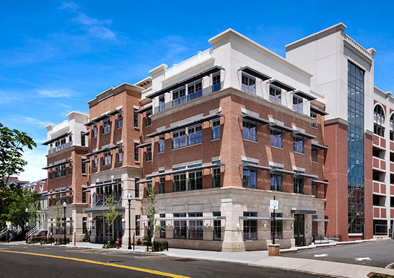
14 Maple Avenue, Morristown, NJ.
Perhaps best known as Washington’s headquarters in 1776 and 1779, Morristown has a long history that spans from colonial times through its 19th and early 20th century industrial and commercial heyday. It continues into the present, when it has emerged as a regional center. The town green lies at its heart, surrounded by a mix of commercial, office and residential uses. The rail station stands about a quarter-mile away. The town views TOD as a way to maintain its viability, and substantial redevelopment has occurred both near the green and the station. One of the most interesting projects is the Highlands at Morristown Station, a joint-development effort undertaken by NJ Transit.
Mixed results seen in Rahway
Rahway sees TOD as way to address decline in local industry and to revive its moribund downtown. Since the late 1990s, Rahway has undertaken an ambitious agenda of mixed-use redevelopment near its renovated train station in an effort to bring new residents and businesses to its struggling core. Rahway has a mixed record of success. Several projects have been completed and fully occupied, while others remain underutilized or uncompleted.
An excellent “laboratory”
These three locations are providing an excellent laboratory in which to explore the benefits that TOD can bring communities and their residents. The efforts undertaken by these communities to retain population, to grow as regional centers, and to attract new residents and new wealth will provide useful evidence that will inform our survey analysis and lead to a better understanding of the impact of TOD on communities.
We will share the results at the conclusion of our study. It should prove enlightening not only for communities in New Jersey, but for similar communities around the country.
San Jose State University News
Bicycling research in high demand
BY KAREN PHILBRICK, PHD, DIRECTOR, RESEARCH
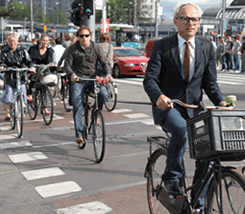
Photo by Ted Sweeney
Bicycling is a growing trend in many cities around the world.
The Mineta Transportation Institute’s research reports on bicycling have proven very popular. This year alone, they have logged more than 100,000 downloads from the MTI web site.
Of particular interest are MTI’s reports on bikesharing and low-stress bicycle network connectivity. Over the past two months each has been downloaded nearly twice as many times as any other MTI report.
We will continue on this topic with additional research now in progress through the Mineta National Transit Research Consortium. Reports that have been completed over the last two years can be downloaded for free on the Research Publications page of the MTI web site. They include:
- Public Bikesharing in North America: Early Operator and User UnderstandingEvaluates public bike sharing in North America, reviewing the advances in technology and major events during its rapid expansion.
- Low-Stress Bicycling and Network Connectivity Develops measures of low-stress connectivity that can be used to evaluate and guide bicycle network planning.
- An Examination of Women's Representation and Participation in Bicycle Advisory Committees in California Examines women’s membership levels in and experiences serving on California bicycle advisory committees and bicycle/pedestrian advisory committees.
- Promoting Bicycle Commuter Safety Presents an overview of the risks associated with cycling to emphasize the need for safety.
- Integration of Bicycling and Walking Facilities into the Infrastructure of Urban Communities Highlights best practices and identifies program characteristics associated with high levels of non-motorized travel, with an emphasis on bicyclists and pedestrians.
- Bicycling Access and Egress to Transit: Informing the Possibilities Aids in developing a framework to evaluate the cost effectiveness of different strategies to integrate transit and bicycling.
- Measuring Walking and Cycling Using the PABS (Pedestrian and Bicycling Survey) Approach: A Low-Cost Survey Method for Local Communities Develops a low-budget survey method and related sampling strategy for communities to easily, affordably, and reliably document the amount of local walking and cycling among their residents.
As non-motorized transportation becomes more popular, our ongoing research will contribute greatly to helping urban planners, transportation engineers, policymakers, and others obtain the necessary data to make accurate decisions.
MSTM alumni make waves
BY PETER HAAS, PHD
DIRECTOR, MTI EDUCATION PROGRAMS
Alumni from MTI’s Master of Science in Transportation Management have gone on to outstanding careers.
Ahron Hakimi leads the local COG
Here in California, Kern County’s Council of Governments appointed alumnus Ahron R. Hakimi as the agency’s seventh executive director. The agency is responsible for transportation planning among local governments, the Golden Empire Transit District, the Federal Highway Administration, the Federal Transit Administration, the California Department of Transportation (Caltrans), and other stakeholders. Ahron, a colonel in the U.S. Army Reserve and a registered civil engineer, helped build roads in Iraq. He also has a long career with Caltrans.
Boris Deunert wins Emerson Rhyner Award
Alumnus Boris Deunert, a senior environmental planner with Caltrans, won the Emerson Rhyner Award, which recognizes contributions to transportation by non-engineering Caltrans managers. His significant contributions have delivered a greatly improved working relationship with his department’s external partners. He’s also helped to increase productivity in his department’s function, all during a year with added workload and staff furloughs. This increase, along with his innovation, has streamlined collaboration among public agencies and benefited taxpayers as more infrastructure projects were built with fewer resources.
Michael Litschi wins Parker Award
The Council of University Transportation Centers presented the coveted Neville A. Parker Award to alumnus Michael Litschi, a section manager at the Orange County (Calif.) Transportation Authority. His paper, Video-Based Driver Risk Management Systems: Evaluating Effectiveness at Improving Transit Safety, won the award for an outstanding non-thesis paper in policy and planning. Earlier in the year, Michael was named MTI’s Student of the Year.These are just a sample of the strides our graduates have made in their transportation careers. Learn more about our Master of Science in Transportation Management.
Our dance card has been full
BY DONNA MAURILLO, MSTM
DIRECTOR, COMMUNICATIONS & TECHNOLOGY TRANSFER
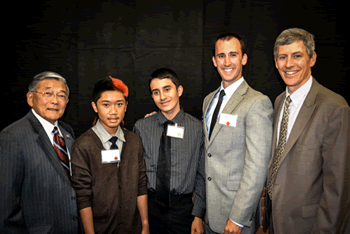
2012 Garrett Morgan winners from Morada Middle School meet with Secretary of Transportation (ret) Norman Mineta (left) and MTI Board Chair Steve Heminger (right).
The Mineta Transportation Institute has been running double-time this year, with a calendar brimming with presentations and special events.
Attend our high-speed rail workshop
MTI has been invited to organize a day-long workshop on high-speed rail at the annual Transportation Research Board conference in Washington DC. We will announce the program in our next newsletter, but put it on your calendar for Sunday, January 20, in the Blue Room at the Omni Shoreham Hotel. With national plans for high-speed rail shaping up, this will be an ideal place to learn all about it.
Board meeting included airport tour
This past June, our board held its summer meeting in a conference room at Mineta San Jose International Airport. We were given a behind-the-scenes tour of airport operations, where we saw how precisely baggage is handled and screened. It was truly funny to see Secretary Norman Mineta wearing an Escort Required badge around the airport that was named for him.
Executive director speaks on high-speed rail
In August, the U.S. Department of Transportation’s Research and Innovative Technology Administration (RITA) presented a free podcast as part of its monthly Transportation Innovation Series. The program, which can be viewed online, featured MTI Executive Director Rod Diridon presenting on California High-Speed Rail and Why It’s Important for the Nation.
In September, he spoke at Podcar City Berlin on the interconnectivity between these people movers and high-speed rail. Then he went on to Uppsala, Sweden to help develop a collaborative relationship between MTI and Uppsala University.
Building international partnerships
MTI also has developed collaborative relationships with entities in China, India, and Japan. Earlier this year, we hosted a visiting scholar from the Shanghai's China Academy of Transportation Sciences. During his two-month stay, he learned about American transit systems and how they operate.
Garrett Morgan competition underway
This month, MTI will be ramping up for its annual Garrett Morgan Sustainable Transportation Competition. This involves teams of middle-school students who develop and present their ideas for greener mobility. The competition is delivered in March by way of national teleconferencing, so students participate with live streaming. Winning teams receive cash prizes for their classrooms, and the top team receives a plaque at our annual awards banquet in June. One special feature is that the U.S. Secretary of Transportation always participates, answering direct questions from the students. The 2012 winning team came from Morada Middle School in Stockton, Calif.
The MTI and MNTRC web sites have updated information about all events and current research. Everything is free for download.
Research in progress: What makes regional transit work?
Leo Hanifin, PhD, Dean, College of Engineering and Science
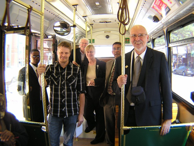
Leo Hanifin (right) rides Detroit transit with his colleagues.
UNIVERSITY OF DETROIT MERCY NEWS – The University of Detroit Mercy (UDM) is studying the factors that enable and inhibit the development and operation of effective regional transportation systems in Southeast Michigan (Detroit metro area). The research team expects that the findings will apply broadly and have value to regions across the nation. They will explore ten specific areas, including governance structures; the relationship of transit to other key broader issues of urban health, including economic development, land use and sustainability; legal structures and issues; funding structures and competing priorities; public-private partnerships and roles; and other key areas.
The first two phases of the five-phase research plan are currently underway. The phases include:
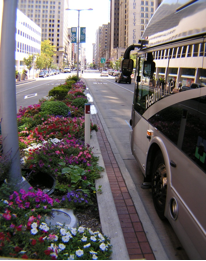
A dedicated bus lane helps move transit.
- Other Cities: Experiences in other cities and related studies on the development and operation of effective regional transit systems
- Detroit History: Successes and failures of regional transit in metropolitan Detroit
- Detroit’s Current State and Opportunities
- Comparing Detroit to Best- and Worst-Case Urban Models
- Analysis and Recommendations
Researchers include experts in key areas of the investigation:
- Dr. Leo Hanifin, principal investigator, is a professor of mechanical engineering at UDM. He was principal investigator for the Woodward Transit Catalyst Plan Project that created a plan leading to a public-private partnership to reintroduce rail-based transit in Detroit.
- Lloyd A. Semple is Dean of UDM’s School of Law.
- Dr. Utpal Dutta, PE, is a professor in UDM’s Department of Civil, Architectural and Environmental Engineering.
- Claudia Bernasconi is a registered architect in the European Union and an assistant professor of Architecture at UDM.
- Dr. Alan S. Hoback, PE, is chair of Civil, Architectural and Environmental Engineering at UDM.
- Scott Douglas, graduate assistant, is a transportation professional on educational leave from the Michigan Department of Transportation.
- Mariarosaria Di Palo, graduate assistant, holds bachelors and masters degrees in architecture from the University of Roma Tre in Rome, Italy.
In addition, many others with extensive knowledge and expertise in transportation in SE Michigan will be involved in this project. They include Megan Owens, director of Transportation Riders United (TRU); Carmine Palombo, director of Transportation Planning, Southeast Michigan Council of Governments (SEMCOG); John Hertel, director of SMART; and Paul Childs of M1 Rail.
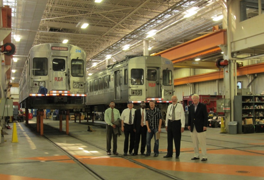
Leo Hanifin and a group of colleagues visit a Detroit transit facility.
Four regions to be studied
To learn from other cities that have faced and overcome similar challenges, the team selected four regions to study in depth – Atlanta, Cleveland, Denver, and St. Louis. In August, five members of the team visited the Regional Transit Authority (RTA) in Cleveland.
The team was impressed with the leadership of Joe Calabrese, RTA general manager, and with the newest element of the RTA system, the Health Line Bus Rapid Transit (BRT) System. The photos provide views of a BRT station, street improvement, and transit oriented developments resulting from this transit investment.
UNLV hosts transportation summer camp
Hualiang (Harry) Teng, PhD, Associate Professor, Civil and Environmental Engineering
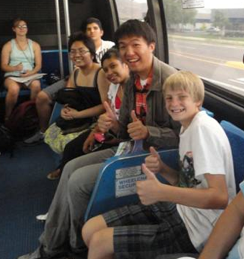
High school students test the limits of public transit at UNLV transportation summer camp.
UNLV NEWS – Dr. Zongzhong Tian from the University of Nevada, Reno (UNR) led a Transportation Summer Camp, which had activities in Reno and Las Vegas. Dr. Harry Teng assisted with activities in Las Vegas. The summer camp, designed for high school students, ran from July 9-19, 2012.
A bus-riding competition was held in Reno. Each student received a bus map, schedule, and pass. Starting from the Main Street Station, a team of four students took and transferred buses until they returned to the starting point. Each student was given three hours to travel as far as possible in the Reno-Sparks region.
Careful planning needed
Given this time constraint, the teams were to develop their own strategies. For example, students could take fewer but longer routes, while others might use shorter, but quicker routes. While creating these travel plans, teams had to minimize waiting-times during bus transfers. After plans were established, the teams implemented them in the field. With distances measured from the Main Street Station, and locations logged through photos, the first-place team accumulated over 35 miles, proving the efficiency and convenience of the Reno-Sparks public transit system.
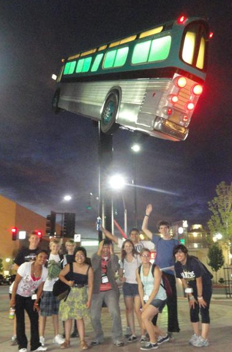
Students gather near Reno’s Main St. terminal before teams competed to see how far they could travel by bus in 3 hours.
While in Las Vegas, the students were given a presentation by Mr. David Swallow about the public transportation system, RTC Transit. This is operated by the Regional Transportation Commission (RTC) of Southern Nevada. RTC Transit consists of various public transportation modes, including regular buses, rapid transit buses, and paratransit. RTC’s bus rapid transit (BRT) system is one of the best in the nation. In the field, the students learned how the BRT system runs, as well as the technologies that make buses move efficiently through the system.
Site tours boost understanding
The students also toured a state-of-the-art transit terminal, Bonneville Transit Center, designed to complement the redevelopment and revitalization of the downtown Las Vegas area. From these activities, the students understood how important public transportation is to a society. Even the parents commented that it was the first time they had understood how the transportation systems worked, including public transit. The camp was so successful that transportation summer camps likely will be continued, giving more focus on public transportation.
-
Contact Us
San José State University One Washington Square, San Jose, CA 95192 Phone: 408-924-7560 Email: mineta-institute@sjsu.edu





